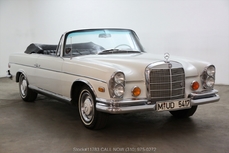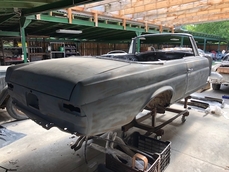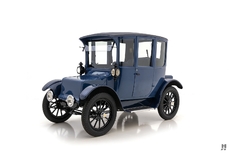Mercedes-Benz 300SE Cabriolet w112 1967
General description :
Mercedes-Benz was undergoing a dramatic transformation in the late 1950s. With their post-war recovery efforts essentially complete, they began to streamline their product line through platform sharing; taking advantage of the economies of scale they enjoyed as one of the world’s largest automakers. The passenger car line was led by the ageing 300 “Adenauer” series; large, body-on-frame limousines, coupes and cabriolets that were expensive and time consuming to manufacture. With the 600 “Grosser” still a few years away, a new and modern flagship was needed. Utilizing the existing W111 platform, Mercedes stuffed the Adenauer’s (also shared with the 300 S and SC) M189 3.0 liter, all-alloy inline-six under the bonnet, added luxurious trimmings and updated the chassis with a sophisticated air-ride suspension system. The changes were enough to necessitate a new internal designation: W112. The W112 300 SE debuted in 1961, available only as the four-door “Heckflosse” (fin-tail) saloon. In 1962, it was joined by the restyled 2-door coupe and cabriolet. The 2-door cars were very modern and elegant, eschewing the sharp fins of the saloon for a more subtly rounded treatment on the rear quarters. The revised styling was the work of the great master Paul Bracq, who had become head of Sindelfingen, Mercedes’ spiritual design center, in 1959. Bracq’s freshened design was so well-received that it inspired both the W111 saloon’s replacement (W108), and carried over when the W112 was replaced by the conventionally sprung W111 2-door.
Despite its shared-platform roots, the W112 was still a very prestigious and expensive car. When the 2-door coupe was first shown on the 1961 auto show circuit, the list price was twice that of another new grand touring car that debuted the same year: Jaguar’s E-Type. 300 SE Coupes and Cabriolets were intended for the most discerning of buyer; those who valued luxury, understated style and exceptional quality. Due to their high cost and hand-assembled construction, very few found buyers, with just 3,127 combined coupes and cabriolets sold through the end of 1967.
This handsome 1967 300 SE Cabriolet is a very desirable example from the final year of W112 production. Presented in the very attractive color combination of Weissgrau (White-Gray, code 158) over a fresh dark green leather interior and a dark green top, it is one of just 708 W112 Cabriolets produced from 1962-1967. The subtle light gray paintwork suits the elegant Paul Bracq-designed body and it is correctly adorned with chrome wheel arch and body side moldings that distinguish the 300 SE from its lower-spec brethren. The body is straight, with factory-precise fitment of the doors and deck lids. A recent bare-metal respray in the correct original color (per the trim tag) presents in excellent condition, with deep gloss and straight reflections. Doors shut with the satisfying solidity of a 60’s era Mercedes-Benz, and the fitment of the trim is very good. Bumpers are straight, with nice quality plating, while the remaining bright trim is tidy and smart, with some restoration work being done as needed at the time of the respray. The original steel wheels have been repainted in body color, adorned with color-keyed two-piece wheel covers as correct. This is a handsome and understated automobile; a refined, sophisticated interpretation of Mid-Century Modern design.
A highlight of this car has to be the wonderful, freshly-restored green leather interior which stands out brilliantly against the light gray paintwork. Taut, fresh upholstery on the front and rear seats is done in the period correct pattern and colors. Interior panels have also been carefully restored and the floors are correctly lined in green-gray square weave carpeting, bound in matching green leather. It is a wonderful yet seldom seen combination that suits the car brilliantly. In addition to the new upholstery, the typically fragile woodwork has been fully restored by the experts at Madera Concepts with stunning results. Fitted with original instrumentation, the original VDO clock, a period correct Becker Europa stereo and a factory Kuhlmeister air conditioning unit; the dash presents beautifully, particularly with its renewed woodwork. Literally topping off the fabulous new interior is a lovely, fully lined convertible top in dark green German canvas which has been expertly fitted and remains taut and free of creases. A top boot in matching green leather is included to keep a sleek look when the roof is folded. The trunk is correctly detailed with a factory original gray rubber mat, and a set of original tools is included in the factory-supplied tool roll.
Mechanically, this 300 SE is in excellent order. Showing approximately 60,000 miles, it sits proud on the original air suspension, with a tidy, well-presented undercarriage and engine bay. As a later production W112, this car’s fuel injected, 3.0 liter, M189 inline six-cylinder engine produces 170 horsepower (ten more than the earlier cars) and sends its power through a column-shifted Mercedes-Benz four-speed automatic transmission. The engine is very well detailed and tidy, showing recent service. It runs well, delivering strong performance and exquisite ride quality thanks to that sophisticated pneumatic ride control.
A true flagship Mercedes-Benz, the W112 300 SE was a beautifully engineered and meticulously hand-built luxury grand touring car that was designed to appeal to only the most discriminating buyers. The rarity and exceptional quality of this fine car makes it highly sought after by today’s collectors, while the advanced engineering and exquisite build quality makes it an exceptional driver’s car, ideally suited for tours and rallies the world over. Much has been spent on this highly desirable 300 SE to ensure it is a beautiful and thoroughly usable example that can keep up to the demands of its next owner.
https://hymanltd.com/vehicles/5613
1967 Mercedes-Benz 300SE Cabriolet w112 is listed sold on ClassicDigest in St. Louis by Mark Hyman for $269500.
Car Facts
Car type : Car Make : Mercedes-Benz Model : 300SE Cabriolet w112 Engine size : 0.0 Model Year : 1967 Sub type : Convertible Location : Missouri
Sold
Seller Information
Sold
People who viewed this Mercedes-Benz 300SE Cabriolet w112 also viewed similar Mercedes-Benz listed at ClassicDigest
Other cars listed for sale by this dealer
About Mercedes-Benz
In the annals of automotive history, the journey of Mercedes-Benz is a tale that unfolds with the ingenuity of its founding pioneers. In the year 1886, Karl Benz crafted the Benz Patent Motorwagen, a creation that would go down in history as the world's inaugural automobile. Unbeknownst to him, this moment marked the genesis of what would evolve into the most illustrious premium car manufacturer globally. The financial underpinning of this pioneering venture, interestingly, was provided by Karl Benz's wife, Bertha Benz, demonstrating a remarkable partnership that would set the tone for Mercedes-Benz's legacy.A parallel narrative emerged not far away, as Daimler-Motoren-Gesellschaft, founded by Gottlieb Daimler and Wilhelm Maybach, entered the scene. In 1901, they unveiled their automobile under the now-famous moniker "Mercedes," meaning "godsend" in Spanish. This name was bestowed upon the car at the behest of Emil Jellinek's daughter, the distributor for Daimler-Motoren-Gesellschaft. The wheels of innovation were set in motion.
Fast forward to 1926, a pivotal year that witnessed the merger of Daimler with Benz & Cie., culminating in the birth of Daimler-Benz. The amalgamation saw the adoption of "Mercedes-Benz" as the distinguished trademark for their automobiles, fusing the legacies of two visionary entities into one.
Contrary to perceptions of conservatism, the trajectory of Daimler-Benz unfolds as a chronicle of industry firsts. From the introduction of the honeycomb radiator to the float carburetor, and the pioneering implementation of four-wheel brakes in 1924, Daimler-Benz consistently pushed the boundaries of automotive innovation. The diesel-powered Mercedes-Benz 260 D in 1936 marked the inception of diesel engines in passenger cars. The iconic Mercedes-Benz 300SL Gullwing made history as the first car with direct fuel injection, albeit the Gutbrod's tiny 2-stroke engine can claim precedence.
Safety innovations became a hallmark, with Béla Barényi's patented safety cell design in the "Ponton"-models in 1951, featuring front and rear crumple zones. The W116 450SEL 6.9 saw the introduction of the Anti-Lock Brake system (ABS), another pioneering safety feature. From the first production airbags and beyond, the legacy of "firsts" continued to be etched into the fabric of Daimler-Benz.
Over its centennial journey, Mercedes-Benz has not merely produced cars but has sculpted automotive icons. The SSKL, 710 SSK Trossi Roadster, 770K Grosser, 540K Spezial Roadster, 300SL Gullwing, w100 600 Pullman, w111 280SE 3.5 Flachkühler, w113 230SL Pagoda, w109 300 SEL 6.3, and w201 2.3-16 Cosworth stand testament to the brand's commitment to engineering excellence.
The roaring Silver Arrows, or "Silberpfeile," including the W 25, W 125, W154, W165, and W196, created a legacy of dominance on the racetrack. These machines were not merely cars; they were expressions of precision, speed, and an indomitable spirit that left their competitors in the dust.
As Mercedes-Benz marches into the future, it does so not just as an automaker but as a custodian of a legacy, a torchbearer of innovation, and a beacon of automotive excellence. The road ahead is sure to witness the continued fusion of cutting-edge technology, timeless design, and an unwavering commitment to setting new standards in the world of automobiles.
One luminary figure who left an indelible mark was Béla Barényi, often heralded as the "father of passive safety" for his pioneering work in safety engineering. His patented safety cell design, featuring front and rear crumple zones, became a hallmark of Mercedes-Benz's commitment to occupant safety, setting new standards that reverberated throughout the automotive world.
Moving through the chronicles, the collaborative genius of Wilhelm Maybach, alongside Gottlieb Daimler, laid the foundation for Daimler-Motoren-Gesellschaft. Their innovations not only birthed the first Mercedes but established a culture of relentless pursuit of technological excellence that remains integral to Mercedes-Benz's DNA.
In the post-merger era of 1926, Ferdinand Porsche emerged as a prominent figure within Mercedes-Benz. His work on the Mercedes-Benz S-Type, a supercharged race car, garnered acclaim and set the stage for a legacy that extended far beyond the marque. Porsche's impact would later extend to his eponymous company, but his influence at Mercedes-Benz during those formative years was pivotal.
As the 20th century progressed, the legendary Rudolf Uhlenhaut emerged as a key figure. Uhlenhaut, an accomplished engineer and the driving force behind the iconic Silver Arrows, played a crucial role in Mercedes-Benz's dominance in motorsports. His engineering prowess and attention to detail were instrumental in creating some of the most formidable racing cars of the era.
In the latter half of the century, figures like Bruno Sacco, the head of design at Mercedes-Benz from 1975 to 1999, left an indelible imprint on the brand's aesthetic identity. Sacco's design philosophy, characterized by clean lines and timeless elegance, shaped iconic models like the W126 S-Class and the W201 190E, solidifying Mercedes-Benz's reputation for luxury and sophistication.
The narrative would be incomplete without acknowledging the contributions of engineers like Hans Scherenberg, whose leadership in the 1970s ushered in a new era of technological innovation at Mercedes-Benz. Scherenberg's tenure saw the development of groundbreaking technologies, including the Anti-Lock Brake system (ABS) and the introduction of airbags in production cars.











